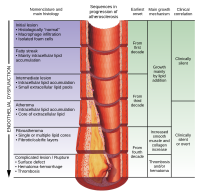
Photo from wikipedia
Significance Despite being identified as the strongest genetic risk factor for Alzheimer’s disease more than 20 years ago, a connection between the biochemical properties of apolipoprotein E (ApoE) and its… Click to show full abstract
Significance Despite being identified as the strongest genetic risk factor for Alzheimer’s disease more than 20 years ago, a connection between the biochemical properties of apolipoprotein E (ApoE) and its role in the disease remains elusive. This is largely due to the limited structural information available for the different forms adopted by the protein (monomer, dimer, tetramer, and lipid bound) across pathogenic and nonpathogenic variants. Here, we provide the characterization of the full-length pathogenic ApoE4 in its monomeric form both in the presence and absence of lipids. We demonstrate that the protein does not adopt a single structure, but a multiplicity of different conformations, which impacts the interpretation of the structure-function mechanism of ApoE.
Journal Title: Proceedings of the National Academy of Sciences of the United States of America
Year Published: 2023
Link to full text (if available)
Share on Social Media: Sign Up to like & get
recommendations!